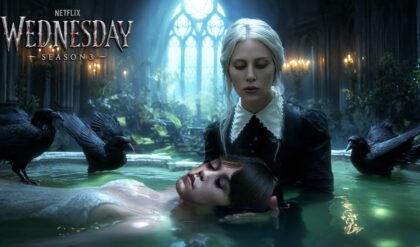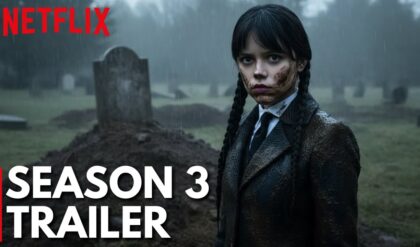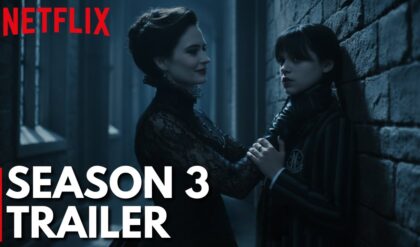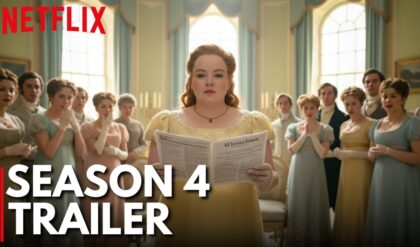Netflix’s The Four Seasons, a modern reimagining of Alan Alda’s 1981 film, has captivated audiences with its sharp comedy, heartfelt drama, and an ensemble cast that brings lifelong friendships to life. Premiering on May 1, 2025, the eight-episode first season, created by Tina Fey, Lang Fisher, and Tracey Wigfield, follows three couples—Kate (Fey) and Jack (Will Forte), Nick (Steve Carell) and Anne (Kerri Kenney-Silver), and Danny (Colman Domingo) and Claude (Marco Calvani)—as they navigate quarterly vacations rocked by personal upheavals. The season’s finale, titled “Fun,” delivers a gut-punch twist with Nick’s unexpected death and a hopeful yet bittersweet revelation about Ginny (Erika Henningsen), Nick’s younger girlfriend, leaving fans reeling and eager for answers. What happened to Nick? How does Ginny’s pregnancy reshape the group? And what could Season 2 hold for this tight-knit circle? Let “

The Shocking Fate of Nick: A Departure from the Original
At the heart of Season 1’s drama is Nick, played with nuance by Steve Carell, whose midlife crisis sets the story in motion. Early in the season, Nick stuns his friends by announcing his divorce from Anne after 25 years, choosing instead to pursue a relationship with Ginny, a vibrant dental hygienist in her 30s. This decision fractures the group’s dynamic, forcing them to adjust to Ginny’s presence on their vacations while Anne grapples with betrayal and loss. Nick’s arc is one of seeking vitality—a man desperate to feel alive again—but it culminates in tragedy that diverges sharply from the 1981 film, where Nick survives and builds a life with Ginny.
In Episode 7, during a New Year’s Eve ski trip, Nick struggles to connect with Ginny’s younger friends, mirroring the isolation he criticized in Anne. After a heated argument where Ginny calls out his lack of effort, Nick drives to a grocery store to buy vegan and gluten-free snacks, hoping to make amends. Tragically, he never returns. Kate receives frantic messages from Ginny, revealing that Nick died in a car accident, a twist that shocks the group and viewers alike. This bold narrative choice grounds the series in the harsh realities of middle age, where sudden loss can upend even the most settled lives. Unlike the film, where Nick’s story ends with hope, the show uses his death to explore grief’s ripple effects, setting the stage for profound character growth.
Nick’s absence in the finale, Episode 8, looms large. His funeral, a chaotic mix of comedy and sorrow, underscores the group’s struggle to memorialize a man who meant different things to each of them. From Kate haggling with a funeral director (resulting in Nick’s ashes in a red high-heel urn) to Anne’s unraveling eulogy, the episode captures the messiness of mourning. Nick’s death isn’t just a plot device; it’s a catalyst that forces his friends to confront their own vulnerabilities, relationships, and the fleeting nature of life.
Ginny’s Baby: A Bittersweet New Beginning
The finale’s most poignant twist comes at a dinner table, echoing the group’s earlier gatherings. As the friends toast to Nick’s memory with Scotch, Ginny quietly sets her glass down, prompting Anne to reveal a bombshell: Ginny is pregnant with Nick’s child. This revelation, subtly foreshadowed by Ginny’s emotional turmoil, mirrors the original film’s ending but carries deeper weight in the show’s context. With Nick gone, the baby represents both a piece of his legacy and a complex challenge for the group, particularly Anne, whose daughter Lila (Julia Lester) will now have a half-sibling.
Ginny’s pregnancy emerges from her vulnerable conversation with Anne outside the funeral. Grieving and guilt-ridden over their fight before Nick’s death, Ginny shares her pregnancy off-screen, a moment of trust that marks a turning point in her relationship with Anne. Throughout the season, Ginny faced resistance from the group, who struggled to accept her as more than a “blip” in Nick’s life. Kate’s harsh words—that Ginny’s eight-month relationship pales against Anne’s 25-year marriage—cut deep, but Ginny’s insistence on her love for Nick forces the group to reconsider her place. Anne’s decision to embrace Ginny, acknowledging that Nick was happier with her, is a powerful act of reconciliation, transforming their rivalry into a fragile alliance.
The baby ties Ginny to the group irrevocably, ensuring her role in their future. It also raises questions about her dynamic with Lila, who expressed anger toward Ginny in a scathing college play, and how the friends will support a young single mother in their midst. The pregnancy offers hope—a new life amid loss—but complicates the group’s vacations, which may now include a toddler. This twist sets up rich storytelling possibilities, blending humor (imagine Jack’s hypochondria around a baby) with drama (Anne and Ginny navigating their shared connection to Nick’s children).
The Group’s Evolution: Healing Through Friendship
The finale is as much about the group’s resilience as it is about Nick and Ginny. Each couple faces personal struggles intensified by Nick’s death, but the episode ends with a sense of renewal. Kate and Jack, whose marriage teetered on stagnancy, find clarity after a near-death experience on a frozen lake. Kate’s fall through the ice, and Jack’s quick thinking to save her, rekindles their bond, culminating in Kate calling Jack her “soulmate”—a term she once mocked when Ginny used it. Their recommitment to therapy and each other reflects the show’s theme of cherishing what matters.
Danny and Claude, the group’s openly gay couple, navigate their own tensions. Danny’s heart condition and reluctance to face surgery strain his relationship with Claude, who copes with Nick’s death by seeking spiritual meaning, likening Nick to a butterfly. Danny initially resists this metaphor, craving space to grieve, but a drawing by Lila labeled “Daddy” with a butterfly softens his stance, suggesting openness to Claude’s perspective. Their honest conversation about differing grief styles strengthens their partnership, highlighting the show’s modern inclusivity compared to the original film.
Anne’s arc is perhaps the most transformative. Her struggle to deliver Nick’s eulogy—admitting she no longer knew him—reveals the pain of their fractured marriage. Yet, her choice to comfort Ginny, despite initial hostility, shows growth. By welcoming Ginny into the group and wearing her sweater, Anne embraces a new chapter, free from the need to compete with Nick’s memory. The final dinner, with Ginny in Nick’s chair, symbolizes the group’s ability to evolve while honoring their past, a testament to the enduring power of friendship.
What’s Next for The Four Seasons?
While Netflix has not confirmed a second season as of May 9, 2025, the finale’s open-ended nature and the show’s success—claiming the #1 spot on Netflix’s TV charts—fuel speculation. The creators have expressed enthusiasm for continuing the story, with a focus on the core cast (Fey, Forte, Domingo, Calvani, Kenney-Silver, Henningsen) and Ginny’s integration. Steve Carell’s return seems unlikely, though flashbacks could weave Nick into the narrative, perhaps exploring his happier moments with Ginny or unresolved tensions with Anne.
Season 2 could follow the same vacation-per-season format, with new destinations like Claude’s family home in Italy or a baby-friendly getaway for Ginny. Thematically, the show is poised to delve deeper into midlife transitions—parenting, aging, and redefining relationships. Ginny’s journey as a single mother, potentially clashing with Lila’s resentment, offers dramatic potential, while Anne’s rediscovery of self could involve new romances or creative pursuits, like her ceramics. Kate and Jack might face fresh marital hurdles, perhaps tied to their daughter Beth’s college life, while Danny and Claude could explore adoption, hinted at by Danny’s reaction to Lila’s drawing.
The show’s strength lies in its ensemble chemistry and ability to balance humor with heartache. Whether it’s Jack’s neurotic quips, Kate’s sardonic wit, or Danny’s quiet strength, the characters feel like old friends, inviting viewers to invest in their next chapter. The inclusion of Vivaldi’s concertos, a nod to the original, could continue to underscore the seasons, while new settings might amplify the vacation envy that made Season 1’s locales (Puerto Rico, upstate New York) so appealing.
Why the Finale Has Fans Buzzing
The finale’s blend of tragedy and hope has sparked fervent discussion online, with fans praising the cast’s performances and the writing’s emotional depth. The show’s 77% Rotten Tomatoes score and high completion rates reflect its resonance, particularly with audiences navigating their own midlife complexities. Nick’s death, a risky move, has been lauded for its authenticity, while Ginny’s pregnancy adds a layer of intrigue that keeps viewers hooked. Posts on social media highlight Claude’s unexpected charm and Anne’s growth as standout elements, with many clamoring for more episodes to see how the group navigates its new reality.
As fans await news of a renewal, The Four Seasons stands out as a rare comedy-drama that doesn’t shy away from life’s messiness. It reminds us to hold loved ones close, embrace change, and find laughter even in grief. Whether you’re rewatching Season 1 or planning your own group getaway, the finale’s impact lingers, promising more stories of friendship and resilience if Netflix gives the green light.





